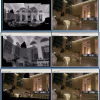Free Online Productivity Tools
i2Speak
i2Symbol
i2OCR
iTex2Img
iWeb2Print
iWeb2Shot
i2Type
iPdf2Split
iPdf2Merge
i2Bopomofo
i2Arabic
i2Style
i2Image
i2PDF
iLatex2Rtf
Sci2ools
ICCV
2007
IEEE
2007
IEEE
A systematic approach for 2D-image to 3D-range registration in urban environments
The photorealistic modeling of large-scale objects, such as urban scenes, requires the combination of range sensing technology and digital photography. In this paper, we attack the key problem of camera pose estimation, in an automatic and efficient way. First, the camera orientation is recovered by matching vanishing points (extracted from 2D images) with 3D directions (derived from a 3D range model). Then, a hypothesis-and-test algorithm computes the camera positions with respect to the 3D range model by matching corresponding 2D and 3D linear features. The camera positions are further optimized by minimizing a line-to-line distance. The advantage of our method over earlier work has to do with the fact we do not need to rely on extracted planar facades, or other higher-order features; we are utilizing lowlevel linear features. That makes this method more general, robust, and efficient. Our method can also be enhanced by the incorporation of traditional structure-from-motion algorith...
Camera Orientation | Camera Pose Estimation | Camera Positions | Computer Vision | Extracted Planar Facades | ICCV 2007 | Texture-map 2D Images |
| Added | 14 Oct 2009 |
| Updated | 30 Oct 2009 |
| Type | Conference |
| Year | 2007 |
| Where | ICCV |
| Authors | Lingyun Liu, Ioannis Stamos |
Comments (0)

